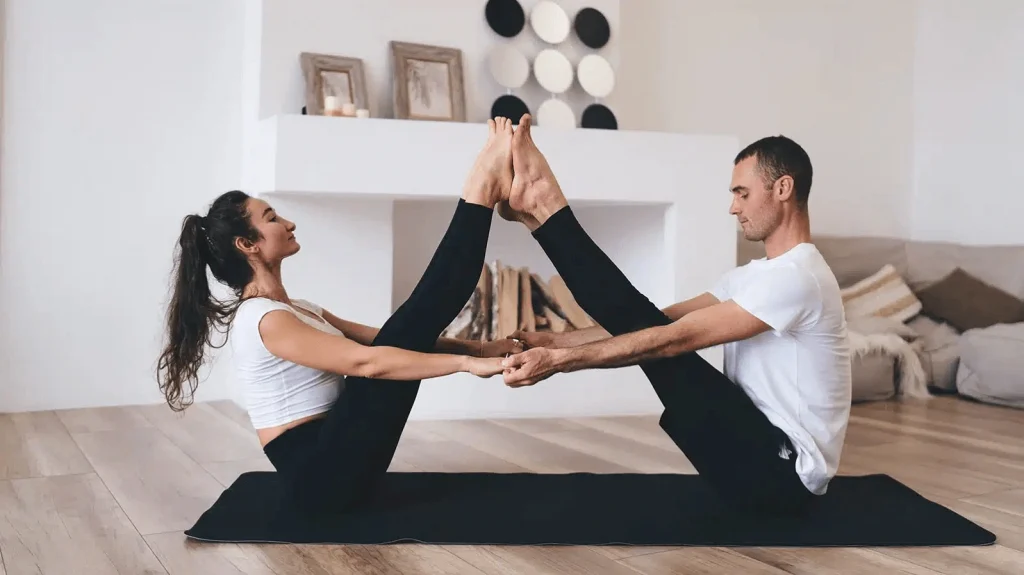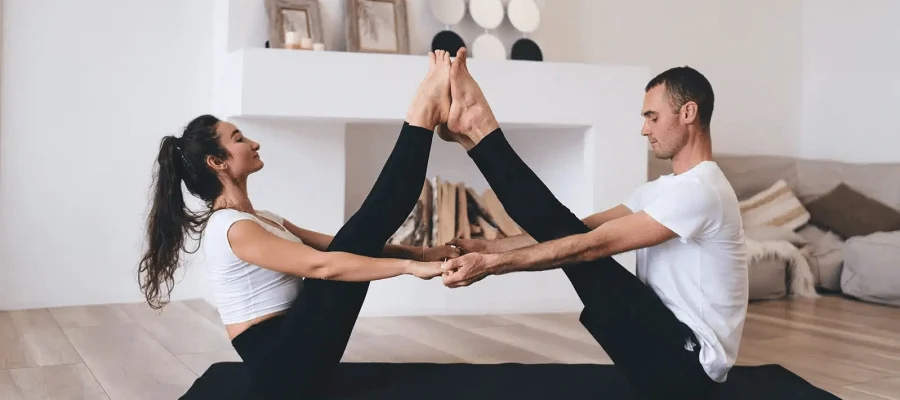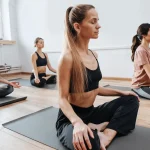Partner yoga isn’t just about synchronizing movements — it’s about trust, support, and communication. Whether you’re beginners or seasoned yogis, practicing yoga poses for two people can strengthen both your body and your relationship.
Practicing together creates more than just a good stretch — it builds emotional awareness, patience, and a sense of shared rhythm. These partner yoga poses will help you explore movement, deepen breath, and build stronger relationships.

Content
Things to Keep in Mind When Practicing Partner Yoga
Before jumping into poses, take a moment to align intentions and expectations. Practicing with another person brings a different energy — here’s how to make it enjoyable for both:
- Communicate openly – Share any physical limitations or discomfort.
- Stay grounded in the breath – Breathe together to stay present.
- Release judgment – It’s about connection, not perfection.
- Move slowly and mindfully – Transitions are as important as the poses.
- Laugh often – Wobbling and falling are part of the process!
15 Partner Yoga Poses for Every Level
Each pose below includes instructions and key benefits. Try them in sequence or pick a few to build your own flow.
1. Seated Grounding Breath
How to: Sit cross-legged back-to-back. Both partners rest hands on knees and sync breath, inhaling and exhaling together.
Benefits: Promotes mindfulness, alignment, and connection.
2. Double Tabletop
How to: Kneel facing each other and press palms together, knees hip-width apart. Extend arms and press into each other gently.
Benefits: Strengthens shoulders, builds awareness of shared balance.
3. Partner Forward Fold
How to: Sit facing each other, legs extended wide. Hold each other’s wrists and take turns gently pulling into a fold.
Benefits: Deepens hamstring stretch and enhances trust.
4. Twin Tree Pose
How to: Stand side-by-side, inner arms around each other’s waists. Lift outer legs into tree pose and press palms together.
Benefits: Improves balance and coordination.
5. Double Downward Dog
How to: One partner comes into downward dog. The other places their hands in front and walks feet onto the lower back (forming an inverted L).
Benefits: Builds upper body strength and core stability.
6. Back-to-Back Chair
How to: Stand back-to-back and slowly lower into a squat position, pressing backs against each other for support.
Benefits: Tones thighs, encourages teamwork and alignment.
7. Partner Boat Pose
How to: Sit facing each other, bend knees, and hold hands. Bring soles of the feet together and extend legs up to form a “W” shape.
Benefits: Engages the core and improves posture.
8. Heart Opener Stretch
How to: Sit back-to-back in a cross-legged position. P1 reaches arms overhead and back; P2 catches the wrists and gently pulls for a chest opener.
Benefits: Opens shoulders and chest; builds trust.
9. Double Warrior II
How to: Face opposite directions, step feet wide apart. Reach front arms to touch fingertips with your partner.
Benefits: Grounds lower body and creates energetic symmetry.
10. Supported Plank Stack
How to: P1 gets into plank pose. P2 carefully stacks their plank pose on top by placing feet on P1’s shoulders and hands on their ankles.
Benefits: Builds core and full-body strength.
11. Seated Spinal Twist
How to: Sit back-to-back, legs crossed. Both partners twist to the right, placing right hand on partner’s knee, then switch.
Benefits: Increases spinal flexibility and encourages mirrored movement.
12. L-Shaped Stretch
How to: Sit facing each other, both partners with legs straight. Place soles of feet together and hold hands, leaning back.
Benefits: Deepens hamstring and inner thigh stretch.
13. Partner Camel Pose
How to: Kneel back-to-back. Reach for each other’s arms and lean back into a gentle camel stretch.
Benefits: Opens chest and stretches hip flexors.
14. Standing Side Stretch
How to: Stand side-by-side with inside arms around each other. Reach outer arms overhead and bend to the side.
Benefits: Stretches side body, improves lateral flexibility.
15. Table Bridge Pose
How to: Sit facing each other with knees bent. Reach across and grip each other’s arms, then lift hips in a tabletop.
Benefits: Strengthens glutes, opens chest.
Final Thoughts: Why Practice Partner Yoga?
Partner yoga offers more than a physical challenge — it’s a gateway to emotional intimacy, trust, and joy. With consistent practice, you’ll not only strengthen your body but also deepen your ability to communicate and co-create in any relationship.
Whether you’re looking for a playful way to connect, strengthen your bond, or just try something new, these partner yoga poses are the perfect way to bring two people into harmony — on and off the mat.
FAQs
What are the benefits of yoga for two people?
Practicing yoga with a partner helps build trust, improve flexibility, and create emotional bonding through shared movement and breath.
Do you need to be flexible to try partner yoga?
Not at all! Many partner yoga poses are beginner-friendly and focus more on balance and coordination than flexibility.

Karen is a health blog author who has been writing about healthy living since 2013. She started her journey by adopting a vegan diet and eating only organic foods, but the more she learned, the more she realized that we should all be eating plant-based diets exclusively. As an expert in nutrition and wellness, Karen blogs to educate readers on how they can live happier and healthier lives through food choices!



